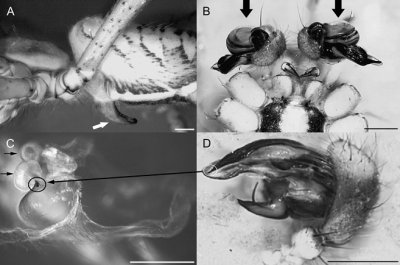I was browsing journals the other day trying to figure out where to send a paper when I came across a paper called Genital damage in the orb-web spider increases paternity success. I guess I have a weird sense of curiosity because I had to take a look and see what they were talking about.
When females of a species mate with several males, evolution can develop some pretty weird adaptations in males competing to fertilize the egg. More numerous, faster or cooperative sperm can improve the chances of their sperm reaching the egg first. Another alternative is to try to prevent other males from mating with that female.
As a way to interfere with other males, many species develop sticky semen to form copulatory plugs blocking other sperm access to the egg. I had heard of this before but what I didn’t know was that some insects have taken this method to an extreme and actually leaves pieces of their genitals behind in the female. These pieces had been shown to protect the males’ sperm against competition by blocking rivals from mating with the female. Similar genital breakage had been observed in spiders but since spider females like to eat their mates and males have two penis-like organs, called pedipalps, scientists debated whether a spider sacrificing one of his genitalia could be a sort of quick release to allow the males to live another day and mate again.
So the authors of this paper (Nessler, Uhl and Schneider) set about solving this question. They figured that if genital damage was a survival tactic then virgin males, who have a second pair of genitals in reserve, should damage their pedipalps more often than males who had already lost one genitalia and have nothing to gain (evolutionarily speaking) by surviving with no genitalia. On the other hand, if broken genitals function as copulation blockers then duration or probability of mating should decrease after a female mates and is stuck with male genital pieces inside her.
Virgin males did appear to be trying harder to escape post-copulatory predation with virgin males cut and running after about 6 seconds and one-genitalia males sticking it out for a lengthy 25 seconds. This resulted in 35% of virgins escaping while only 5% of their more seasoned counterparts avoided post-coital dining. Yet even with these differences in behavior, the researchers still found that genital damage was not significantly different between virgin and one-pedipalp males. This suggests that sacrificing one’s genitals does not make one more likely to escape a cannibalistic female.
On the other hand, the researchers found that males mating with females containing pieces of genitalia copulated about half as long and were 75% less likely to break off their genitals as males mating with either virgin or genitalia-free mated females. Since longer matings increase the chance of that males sperm being successful, genital breakage appears to be a form of copulation plug that increases the evolutionary fitness of that male.
For the curious, the article also included a picture of a) female spiders, b) male pedipalp genitalia, c) a piece of male genitalia stuck in a female, and d) a close-up view of the male pedipalp showing the part that breaks off.

I was surprised to see how small the broken piece of pedipalp was. It’s kind of amazing that losing that little piece of tip results in sterility for that genitalia and blocks other males. Then again, I suppose any genital breakage is too much genital breakage.
References
S. H. Nessler, G. Uhl and J. M. Schneider. 2007. Genital damage in the orb-web spider Argiope bruennichi (Araneae: Araneidae) increases paternity success Behavioral Ecology 18:174-181
{ 6 }
Related Articles
Tangled Bank - Snowy Valentine Edition « Lab Cat | 13-Feb-2007
UDreamOfJanie | 28-Feb-2007
Post-coital ant abdomen amputation :: Dammit Jim! | 02-Mar-2007
Suicidal spider lovers :: Dammit Jim! | 25-Mar-2007
More Spider Mating Rituals: Butt Drumming :: Dammit Jim! | 27-Jul-2007
Gay Flies and White Genes :: Dammit Jim! | 04-Feb-2008
{ 0 }
Comments